Books are an essential part of human culture and learning. They provide knowledge, entertainment, and an escape into different worlds. Whether in print or digital form, books have played a significant role in shaping history and education. This article will explore everything about books, from their structure to their importance in daily life.
Parts of a Book
Every book has key components that help organize information and make reading enjoyable:
- Cover and Title: The cover protects the pages and provides the book’s title and author’s name.
- Author and Illustrator: The author writes the content, while an illustrator adds visual elements (if applicable).
- Spine and Binding: The spine holds the book together and displays the title.
- Table of Contents: Found at the beginning, it lists chapters and page numbers.
- Chapters and Pages: Books are divided into sections called chapters to make reading easier.
- Glossary and Index: Nonfiction books often include a glossary (definitions of key terms) and an index (a list of topics with page numbers).
Types of Books
Books come in many forms and genres:
- Fiction vs. Nonfiction: Fiction books contain made-up stories, while nonfiction books provide factual information.
- Genres of Books: Common genres include fantasy, mystery, science fiction, biography, poetry, and informational texts.
- Formats of Books: Books exist in hardcover, paperback, digital (eBooks), and audiobook formats.
How Books Are Made
Creating a book involves multiple steps:
- Writing and Editing: Authors write the content, and editors refine it.
- Illustration and Design: Illustrators and designers enhance the book’s appearance.
- Printing and Publishing: The final book is printed and published in different formats.
- Distribution and Sales: Books reach readers through bookstores, libraries, and online platforms.

How to Choose a Good Book
Selecting the right book depends on personal interests and reading level:
- Consider topics that excite you.
- Read summaries and reviews.
- Use the “Five Finger Rule” to check reading difficulty.
- Explore different authors and genres to discover new favorites.
Related Article : What are Writing Prompts A Helpful Guide for Teachers
The Benefits of Reading Books
Reading has many advantages:
- Expanding Knowledge: Books provide new information and vocabulary.
- Enhancing Imagination: Fiction books spark creativity and storytelling skills.
- Improving Focus and Comprehension: Regular reading strengthens concentration and understanding.
- Providing Entertainment and Relaxation: Books offer a way to unwind and explore new worlds.
How to Take Care of Books
To keep books in good condition:
- Handle them with clean hands.
- Store them upright on a shelf away from moisture and sunlight.
- Use bookmarks instead of folding pages.
- Donate or recycle old books responsibly.
Conclusion
Books are a treasure trove of knowledge and imagination. Whether you enjoy fiction or nonfiction, reading books can enrich your life in countless ways. By taking care of books and exploring different genres, you can develop a lifelong love of reading. So, pick up a book today and embark on an exciting journey of discovery!
FAQs
Q1: What is the best way to start reading as a beginner?
A: Start with books that match your interests and reading level. Short stories and illustrated books can also help beginners develop a reading habit.
Q2: How do I know if a book is appropriate for my child’s reading level?
A: Use the “Five Finger Rule”: If a child struggles with five or more words on a page, the book may be too difficult.
Q3: What are some recommended books for different age groups?
A: Young children may enjoy picture books like The Very Hungry Caterpillar, while older readers might enjoy Harry Potter or Percy Jackson. Adults can explore classic literature, self-help, or historical fiction.
Q4: How can I develop a habit of reading regularly?
A: Set aside dedicated reading time each day, carry a book with you, and join book clubs or reading challenges.
Q5: Are audiobooks as effective as reading physical books?
A: Yes, audiobooks can improve comprehension and vocabulary, especially for auditory learners, though physical reading may offer better focus and retention for some.
Q6: How can I encourage children to read more?
A: Make reading fun by providing a variety of interesting books, reading together, and creating a cozy reading space.
Q7: What is the difference between an eBook and a printed book?
A: eBooks are digital versions of books that can be read on devices, while printed books are physical copies. Each format has its own advantages and disadvantages based on convenience and preference.


